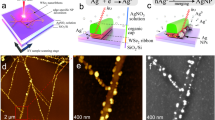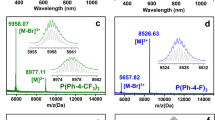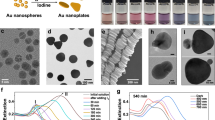Abstract
After more than a decade, it is still unknown whether the plasmon-mediated growth of silver nanostructures can be extended to the synthesis of other noble metals, as the molecular mechanisms governing the growth process remain elusive. Herein, we demonstrate the plasmon-driven synthesis of gold nanoprisms and elucidate the details of the photochemical growth mechanism at the single-nanoparticle level. Our investigation reveals that the surfactant polyvinylpyrrolidone preferentially adsorbs along the nanoprism perimeter and serves as a photochemical relay to direct the anisotropic growth of gold nanoprisms. This discovery confers a unique function to polyvinylpyrrolidone that is fundamentally different from its widely accepted role as a crystal-face-blocking ligand. Additionally, we find that nanocrystal twinning exerts a profound influence on the kinetics of this photochemical process by controlling the transport of plasmon-generated hot electrons to polyvinylpyrrolidone. These insights establish a molecular-level description of the underlying mechanisms regulating the plasmon-driven synthesis of gold nanoprisms.
This is a preview of subscription content, access via your institution
Access options
Subscribe to this journal
Receive 12 print issues and online access
$259.00 per year
only $21.58 per issue
Buy this article
- Purchase on Springer Link
- Instant access to full article PDF
Prices may be subject to local taxes which are calculated during checkout




Similar content being viewed by others
References
Jin, R. et al. Photoinduced conversion of silver nanospheres to nanoprisms. Science 294, 1901–1903 (2001).
Langille, M. R., Personick, M. L. & Mirkin, C. A. Plasmon-mediated syntheses of metallic nanostructures. Angew. Chem. Int. Ed. 52, 13910–13940 (2013).
Xue, C., Millstone, J. E., Li, S. & Mirkin, C. A. Plasmon-driven synthesis of triangular core–shell nanoprisms from gold seeds. Angew. Chem. Int. Ed. 46, 8436–8439 (2007).
Maillard, M., Huang, P. & Brus, L. Silver nanodisk growth by surface plasmon enhanced photoreduction of adsorbed [Ag+]. Nano Lett. 3, 1611–1615 (2003).
Xue, C., Metraux, G. S., Millstone, J. E. & Mirkin, C. A. Mechanistic study of photomediated triangular silver nanoprism growth. J. Am. Chem. Soc. 130, 8337–8344 (2008).
Wu, X. et al. Photovoltage mechanism for room light conversion of citrate stabilized silver nanocrystal seeds to large nanoprisms. J. Am. Chem. Soc. 130, 9500–9506 (2008).
Langille, M. R., Zhang, J., Personick, M. L., Li, S. & Mirkin, C. A. Stepwise evolution of spherical seeds into 20-fold twinned icosahedra. Science 337, 954–957 (2012).
Watanabe, K., Menzel, D., Nilius, N. & Freund, H.-J. Photochemistry on metal nanoparticles. Chem. Rev. 106, 4301–4320 (2006).
Chen, H., Ratner, M. A. & Schatz, G. C. QM/MM study of photoinduced reduction of a tetrahedral Ag20+ cluster by a Ag atom. J. Phys. Chem. C 118, 1755–1762 (2012).
Redmond, P. L., Wu, X. & Brus, L. Photovoltage and photocatalyzed growth in citrate-stabilized colloidal silver nanocrystals. J. Phys. Chem. C 111, 8942–8947 (2007).
Jin, R. et al. Controlling anisotropic nanoparticle growth through plasmon excitation. Nature 425, 487–490 (2003).
Lee, G. P. et al. Light-driven transformation processes of anisotropic silver nanoparticles. ACS Nano 7, 5911–5921 (2013).
Zhai, Y. et al. Superparamagnetic plasmonic nanohybrids: shape-controlled synthesis, TEM-induced structure evolution, and efficient sunlight-driven inactivation of bacteria. ACS Nano 5, 8562–8570 (2011).
Alloyeau, D. et al. Unravelling kinetic and thermodynamic effects on the growth of gold nanoplates by liquid transmission electron microscopy. Nano Lett. 15, 2574–2581 (2015).
Lee, K. E., Hesketh, A. V. & Kelly, T. L. Chemical stability and degradation mechanisms of triangular Ag, Ag@Au, and Au nanoprisms. Phys. Chem. Chem. Phys. 16, 12407–12414 (2014).
Tangeysh, B. et al. Triangular gold nanoplate growth by oriented attachment of Au seeds generated by strong field laser reduction. Nano Lett. 15, 3377–3382 (2015).
Lide, D. R. CRC Handbook of Chemistry and Physics (CRC Press/Taylor and Francis, 2008).
Yang, Y., Liu, J., Fu, Z. & Qin, D. Galvanic replacement-free deposition of Au on Ag for core–shell nanocubes with enhanced chemical stability and SERS activity. J. Am. Chem. Soc. 136, 8153–8156 (2014).
Senoner, M. & Unger, W. E. S. SIMS imaging of the nanoworld: applications in science and technology. J. Anal. At. Spectrom. 27, 1050–1068 (2012).
Millstone, J. E. et al. Observation of a quadrupole plasmon mode for a colloidal solution of gold nanoprisms. J. Am. Chem. Soc. 127, 5312–5313 (2005).
Xia, Y., Xiong, Y., Lim, B. & Skrabalak, S. E. Shape-controlled synthesis of metal nanocrystals: simple chemistry meets complex physics? Angew. Chem. Int. Ed. 48, 60–103 (2009).
DuChene, J. S. et al. Halide anions as shape-directing agents for obtaining high-quality anisotropic gold nanostructures. Chem. Mater. 25, 1392–1399 (2013).
Lohse, S. E., Burrows, N. D., Scarabelli, L., Liz-Marzán, L. M. & Murphy, C. J. Anisotropic noble metal nanocrystal growth: the role of halides. Chem. Mater. 26, 34–43 (2014).
Koh, A. L. et al. Electron energy-loss spectroscopy (EELS) of surface plasmons in single silver nanoparticles and dimers: influence of beam damage and mapping of dark modes. ACS Nano 3, 3015–3022 (2009).
Hartland, G. V. Optical studies of dynamics in noble metal nanostructures. Chem. Rev. 111, 3858–3887 (2011).
Govorov, A. O. et al. Gold nanoparticle ensembles as heaters and actuators: melting and collective plasmon resonances. Nanoscale Res. Lett. 1, 84–90 (2006).
Christopher, P., Xin, H. & Linic, S. Visible-light-enhanced catalytic oxidation reactions on plasmonic silver nanostructures. Nature Chem. 3, 467–472 (2011).
Manjavacas, A., Liu, J. G., Kulkarni, V. & Nordlander, P. Plasmon-induced hot carriers in metallic nanoparticles. ACS Nano 8, 7630–7638 (2014).
Polte, J. et al. Nucleation and growth of gold nanoparticles studied via in situ small angle X-ray scattering at millisecond time resolution. ACS Nano 4, 1076–1082 (2010).
Regalbuto, J. R. Catalyst Preparation: Science and Engineering (CRC Press/Taylor and Francis Group, 2007).
Wu, X., Thrall, E. S., Liu, H., Steigerwald, M. & Brus, L. Plasmon induced photovoltage and charge separation in citrate-stabilized gold nanoparticles. J. Phys. Chem. C 114, 12896–12899 (2010).
Zeng, J. et al. Successive deposition of silver on silver nanoplates: lateral versus vertical growth. Angew. Chem. Int. Ed. 50, 244–249 (2011).
Millstone, J. E., Hurst, S. J., Métraux, G. S., Cutler, J. I. & Mirkin, C. A. Colloidal gold and silver triangular nanoprisms. Small 5, 646–664 (2009).
Tao, A. R., Habas, S. & Yang, P. Shape control of colloidal metal nanocrystals. Small 4, 310–325 (2008).
Xia, Y., Xia, X. & Peng, H. Shape-controlled synthesis of colloidal metal nanocrystals: thermodynamic versus kinetic products. J. Am. Chem. Soc. 137, 7947–7966 (2015).
Li, J., Liu, J., Yang, Y. & Qin, D. Bifunctional Ag@Pd-Ag nanocubes for highly sensitive monitoring of catalytic reactions by surface-enhanced Raman spectroscopy. J. Am. Chem. Soc. 137, 7039–7042 (2015).
Wang, Y. M. et al. Defective twin boundaries in nanotwinned metals. Nature Mater. 12, 697–702 (2013).
Saywell, A., Schwarz, J., Hecht, S. & Grill, L. Polymerization on stepped surfaces: alignment of polymers and identification of catalytic sites. Angew. Chem. Int. Ed. 51, 5096–5100 (2012).
McFarland, E. W. & Tang, J. A photovoltaic device structure based on internal electron emission. Nature 421, 616–618 (2003).
Redmond, P. L. & Brus, L. E. “Hot electron” photo-charging and electrochemical discharge kinetics of silver nanocrystals. J. Phys. Chem. C 111, 14849–14854 (2007).
Lu, L., Shen, Y., Chen, X., Qian, L. & Lu, K. Ultrahigh strength and high electrical conductivity in copper. Science 304, 422–426 (2004).
Scarabelli, L., Coronado-Puchau, M., Giner-Casares, J. J., Langer, J. & Liz-Marzán, L. M. Monodisperse gold nanotriangles: size control, large-scale self-assembly, and performance in surface-enhanced Raman scattering. ACS Nano 8, 5833–5842 (2014).
Chen, L. et al. High-yield seedless synthesis of triangular gold nanoplates through oxidative etching. Nano Lett. 14, 7201–7206 (2014).
Millstone, J. E., Wei, W., Jones, M. R., Yoo, H. & Mirkin, C. A. Iodide ions control seed-mediated growth of anisotropic gold nanoparticles. Nano Lett. 8, 2526–2529 (2008).
Acknowledgements
The work is supported by the Air Force Office of Scientific Research under AFOSR Award No. FA9550-14-1-0304. We also thank the National Science Foundation for support under Grant CHE-1308644 and the CCI Center for Nanostructured Electronic Materials (CHE-1038015). F.O. and B.D. acknowledge the generous support from the University of Florida (UF) Howard Hughes Medical Institute (HHMI) Intramural Award and the UF University Scholars Program. B.Y. acknowledges support from UF’s Student Science Training Program. We thank M. Hill and B. Sumerlin for assistance with zeta potential measurements. Electron microscopy work was carried out in part at the Center for Functional Nanomaterials at Brookhaven National Laboratory (Upton, New York) through User Proposal BNL-CFN-31913 and BNL-CFN-33789, supported by the US Department of Energy (DOE), Office of Basic Energy Sciences, under Contract DE-SC0012704. A portion of the research (AFM and NanoSIMS characterization) was performed at the Environmental Molecular Sciences Laboratory (EMSL) through User Proposal 40065, a national scientific user facility sponsored by the DOE Office of Biological and Environmental Research located at the Pacific Northwest National Laboratory (PNNL) (Richland, Washington). PNNL is operated by Battelle for the US DOE under contract DE-AC06-76RLO1930.
Author information
Authors and Affiliations
Contributions
Y.Z., J.S.D. and W.D.W. conceived the system and designed the experiments. Y.Z., J.S.D., B.Y. and W.G. synthesized the materials. J.S.D., A.C.J.-P., D.S. and E.A.S. performed the EELS and TEM characterization. Y.-C.W. and Z.Z. performed the NanoSIMS characterization. Y.Z., J.Q. and E.W.Z. performed the SEM measurements. Y.-C.W. and D.H. performed the AFM measurement. Y.Z., J.S.D. and W.D.W. analysed and interpreted the data. Y.Z., J.S.D. and W.D.W. prepared the manuscript with contributions from all authors. W.D.W. supervised the project.
Corresponding author
Ethics declarations
Competing interests
The authors declare no competing financial interests.
Supplementary information
Supplementary Information
Supplementary Information (PDF 6236 kb)
Rights and permissions
About this article
Cite this article
Zhai, Y., DuChene, J., Wang, YC. et al. Polyvinylpyrrolidone-induced anisotropic growth of gold nanoprisms in plasmon-driven synthesis. Nature Mater 15, 889–895 (2016). https://doi.org/10.1038/nmat4683
Received:
Accepted:
Published:
Issue Date:
DOI: https://doi.org/10.1038/nmat4683
This article is cited by
-
Photothermally heated colloidal synthesis of nanoparticles driven by silica-encapsulated plasmonic heat sources
Nature Communications (2023)
-
Plasmon-mediated chemical reactions
Nature Reviews Methods Primers (2023)
-
Atomic structure of a seed-sized gold nanoprism
Nature Communications (2022)
-
Effect of light at different wavelengths on polyol synthesis of silver nanocubes
Scientific Reports (2022)
-
Experimental characterization techniques for plasmon-assisted chemistry
Nature Reviews Chemistry (2022)



